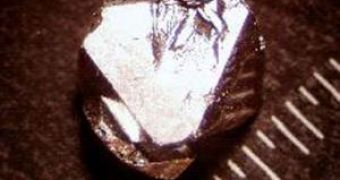Although alchemy takes on many forms, in pop culture it is most often cited in stories, films, shows, and games as the process used to change lead (or other elements) into gold. Also another form that alchemy takes is in the search for the Philosopher's Stone, in which to obtain the ability to transmute gold or other elements to eternal life.
They weren't trying to obtain eternal life (at least not in this experiment), but physicists at the US Department of Energy's Ames Laboratory have discovered a new family of zinc compounds that can be tuned, or manipulated, to take on some of the physical properties and behavior of other materials, ranging from plain old copper to more exotic elements like palladium.
Palladium has a great affinity for hydrogen, being able to absorb 900 times its own volume of the gas. Its complexes are often used in catalysis such as in catalytic converters on cars, palladium on carbon used in organic chemistry, and other coupling reactions. As a precious metal, it is sometimes used in jewelry.
The new zinc compounds can even be manipulated to take on the properties of more complex electronic and magnetic compounds, which researchers say, are on "the hairy edge" of becoming magnetic (or even superconducting) materials.
According to Drs. Paul Canfield and Sergey Bud'ko and their Iowa State University Department of Physics and Astronomy graduate student, Shuang Jia, the compound's versatility makes them ideal for basic research efforts to observe and learn more about the origins of phenomena such as magnetism.
The class of compounds discovered by the research team is over 85 percent zinc, and despite this they display extraordinary tunability.
According to the researchers, if technological applications can be found, these compounds will literally only cost pennies to make.
"We can make compounds for up to 10 transition metals, and for each of those we can include between seven and 14 rare earths. So that's between 70 and 140 compounds. Indeed, we have been able to make scores of different compounds with this one rare earth-two transition metals-twenty zincs formula," said Dr. Canfield.
One of the compounds the researchers made, turned out to be even closer to being ferromagnetic than palladium, a nearly ferromagnetic material that scientists have traditionally studied to better understand magnetism.
"Palladium acts as a "before" picture to their "after" in terms of ferromagnetism. However, the problem is that as an element, palladium is a little hard to tune. There is one palladium site, and it's not that versatile. For basic research as well as possible applied materials, you want compounds that allow for the manipulation of their properties. We can tune the rare earth-iron (2)-zinc (20) so we're able to push these compounds even closer to ferromagnetism and try to understand the consequences of this," said Dr. Canfield.
Canfield, Bud'ko, and Jia have also tuned the zinc (20) compounds by substituting on the rare earth side, for example, by exchanging yttrium for gadolinium.
The researchers can also tune the zinc (20) compounds by "playing" with the transition metal site.
"By substituting cobalt for iron, we can back this material off. The yttrium-cobalt-zinc (20) is about as ferromagnetic as copper, which means it's not. So we can calm the crowd down a little and see what happens," Dr. Canfield said.
The team is now attempting to approach the ferromagnetic transition point from where it is possible to push the material to become ferromagnetic at very low temperatures by tweaking and tuning.
"If we could do that, then we could actually witness the birth of this type of small moment ferromagnetism - instead of just before and after pictures, we could watch the whole film," he added.

 14 DAY TRIAL //
14 DAY TRIAL //